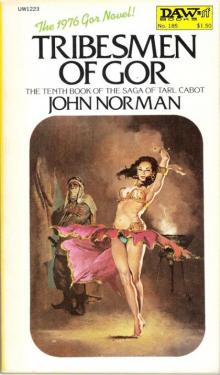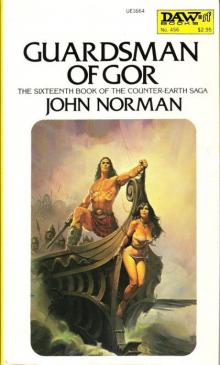- Home
- John Norman
Savages of Gor coc-17 Page 7
Savages of Gor coc-17 Read online
Page 7
"Few red savages live outside of the Barrens," I said, "and those who do wouldpresumably be as unfamiliar with them as would be anyone else in theircircumstances."
"What of the red savages of the Barrens?" asked Samos.
"Such would have to be approached at their own risk," I said. "From the hide wesaw that the mounted hunters were apparently preparing to charge Zarendargarwhen they were interrupted by the man's attack."
"But the translator," said Samos.
"A bewildering complexity of tribal languages is spoken in the Barrens," Isaid," most of them unintelligible to native speakers of the others. I find ithard to believe that their translators would be prepared to deal with any one ofthose languages, let along several of them."
"Zarendargar is then perhaps safe," said Samos.
"Not at all," I said. "Kurii are tenacious. With or without human aid we may besure that they will not rest until they have found their quarry."
"Zarendargar, then, is doomed," said Samos.
"Perhaps," I said.
I glanced again outside the barge, through the now-opened slats of the smallwindow.
On a gently inclined slope of cement leading down to the canal, the waterlapping at her knees, there knelt a slave girl doing laundry. She wore her steelcollar. Her tunic came high on her thighs. It is thought desirable for a femaleslave to work long hours at menial tasks. I smiled to myself. It is pleasant toown a woman, absolutely, in the Gorean fashion.
"It is your belief, then," said Samos, "that the skin is genuine."
"Yes," I said, "and from what I know of the red savages, I would conjecture thatthis skin is from the very beast whose image is portrayed upon it."
"Ai," said Samos. "Perhaps!"
"I think it is more than likely," I said.
"I pity Zarendargar," said Samos.
"He would not appreciate the sentiment," I said.
I moved on the low wooden bench, one of several aligned perpendicularly to theinterior port wall of the enclosed barge. There was a similar set of benchesaligned identically against the starboard wall.
"These benches are uncomfortable," I said to Samos. My legs were cramped.
"They are designed for women," said Samos.
There was room for five women on each bench. With my heel I kicked some light,siriklike slave chains back under the bench. Such chains are too light for aman, but they are fully adequate for a woman. The primary holding arrangementsfor women on the benches, however, are not chains. Each place on the bench isfitted with ankle and wrist stocks, and for each bench there is a plank collar,a plank which opens horizontally, each half of which contains five matching,semicircular openings, which, when it is set on pinions, closed, and chained inplace, provides thusly five sturdy, wooden inserts for the small, lovely throatsof women. The plank is thick and thus the girls' chins are held high. The plankis further reinforced between each girl with a narrowly curved iron band, theopen ends of which are pierced; this is slid tight in its slots, in its metalretainers, about the boards, and secured in place with a four-inch metal pin,which may or may not be locked in place. Each girl is held well in her place,thusly, not only by the ankle and wrist stocks, which hold her ankles back andher wrists beside her, but by the plank collar as well.
"We are passing a market," said Samos. "You had better close the window slats."
I glanced outside. The smell of fruit and vegetables, and verr milk, was strong.
I also heard the chatter of women. Dozens of women were spreading theirblankets, and their wares, on the cement. There are many such markets in PortKar. Men and women come to them in small boats. Also, of course, sometimes thevendors, too, will merely tie up their boats near the side of the canal,particularly when the space on the cement is crowded. The markets, thus, tend toextend into the canal itself. The only fully floating market authorized by theCouncil of Captains occurs in a lakelike area near the arsenal. It is called thePlace of the Twenty-Fifth of Se'Kara, because of the monument there, rising fromthe water. On the twenty-fifth of Se'Kara in Year One of the Sovereignty of theCouncil of Captains, the year 10,12 °C.A. Contasta Ar, from the Founding of Ar,a sea battle took place in which the fleet of Port Kar defeated the fleets ofCos and Tyros. The monument, of course, commemorates this victory. The marketforms itself about the monument. That year, incidentally is also regarded assignificant in the history of Port Kar, because it was in that year that, as itis said, a Home Stone consented to reside within the city.
"Please," said Samos.
I looked at the benches. Most of them were smooth, and, on many, the darkvarnish was all but worn off. Slave girls are normally transported nude.
"Please," said Samos.
"I'm sorry," I said. I closed the window slats by moving one of the slats. Theycan be most easily closed, of course, by moving the narrow, vertically mounted,central wooden lever, but this lever, as would be expected, is on the outside.
The window is designed to be opened and shut from the outside. Too, it can belocked shut, and normally is, from the outside, when cargo is within. As I haveearlier indicated the slave girl is normally transported in total ignorance ofher destination. Keeping a girl in ignorance is commonly thought useful in hercontrol and management. Too, it helps her keep clearly in mind that she is aslave. Curiosity is not becoming in a Kajira is a common Gorean saying. The girllearns quickly that it is not her business to meddle in the affairs of hermaster but, rather, to be beautiful, and serve him, abjectly and totally.
"I do not wish too many to know of our early morning journey," said Samos.
I nodded. We were well known in Port Kar. There was little point in provokingthe populace to idle speculations.
"We are passing another market," I said.
"Verr milk, Masters! ' I heard called. "Verr milk, Masters!"
I opened the slats a tiny crack. I wished to see if she were pretty. She was, inher tunic and collar, kneeling on a white blanket, spread on the cement, withthe brass container of verr milk, with its strap, near her, and the tiny brasscups. She was extremely lightly complexioned and had very red hair.
"Verr milk, Masters," she called. Slaves may buy and sell in the name of theirmasters, but they cannot, of course, buy and sell for themselves because theyare only animals. It is rather for them to be themselves bought and sold, as themasters might please.
"Will you make a report of this morning's business to the Sardar?" I asked.
"A routine report of all such contacts is to be made," said Samos.
"Do you expect the Sardar to take action?" I asked.
"No," said Samos.
"That, too, is my speculation," I said.
It is their custom in most such matters to let matters take their course.
"True," I said.
"Are you interested?" asked Samos.
"I was curious to hear your view," I said. "It coincides with mine, as I hadthought it would."
"Why do you ask?" asked Samos.
"I was curious," I said.
"Oh," said Samos.
We rode together for a time in silence, toward my holding, through the canals.
"I met Zarendargar, in the north," I said.
"That is known to me," said Samos.
"He impressed me as a fine commander, and a good soldier," I said.
"He is a terrifying and dangerous enemy," said Samos. "Men and Priest-Kingswould be well rid of him. Let us hope that the beasts we met this morning willbe successful in their quest."
I looked again through the tiny crack in the slats. It was near the sixth Ahn.
Small boats now moved about on the canal. Most were propelled by the swayingmovement of a steering oar. Some, larger boats and light galleys, such as mightbe used in the Tamber Gulf or, abroad, on Thassa, were being rowed from thwarts.
These vessels were singly or doubly ruddered. In negotiating the canals theirlong, sloping yards were lowered, being then fully or partially inboard, ineither case being aligned with the keel. This was in accord with an ordnance ofPort Kar.
"The Council of Captains must meet in two days," said Samos. "It is proposedthat the Sa-Tarna quay in the south harbor be extended. What division of thiswill be borne by public expense remains moot. Too, if this license be granted,an exploitable precedent may be set. Already there is talk among the merchantsin rep-cloth and the lumber and stone merchants."
We were now passing an open slave market. The merchant was chaining his girls onthe broad, tiered, cement display shelves. One girl lay on her stomach, on herelbows, her head down, the heavy iron collar on her neck visible beneath herhair; a short, weighty chain of thick dark links connected this collar, by itscollar ring, to a wide, stout ring, anchored deeply in the cement, almostbeneath her chin; the chain was no more than six inches long; I gathered thatshe was being disciplined; another girl, a blonde, sat on her shelf with herknees drawn up, her ankles crossed, her arms about her knees; I saw her chaindescend from her collar, disappear behind her right leg, and then reemerge frombehind her right thigh, thence running to the ring to which she was attached;another girl, a long-haired brunet, on all fours, faced me, with glazed eyes,seemingly uncomprehendingly regarding the enclosed barge as it passed by in thecanal; she had just been chained; it is common to put a woman on all fours forneck chaining; the slaver stepped away from her; neck chaining, incidentally, iscommon in a market for female slaves, as it is for she-sleen; several girls,standing, awaited their chaining, in turn, on the tiers; I could see the small,incisive brand marks on their left thighs, high, just below their left hips,they were in ankle coffle, their left ankles chained together; more than one ofthem shaded her eyes against the morning sun; it would be a long day for most ofthem, chained in the sun, on the hard, granular surfaces of the hot cementshelves.
"These issues," said Samos, "are subtle and complex."
The women were chained nude, of course, for that is the way that slave girls arecommonly displayed for their sale, particularly in low markets, and, indeed,even in a private sale from one of the purple booths in the courtyard of a richslaver there will come a time when the slave, even an exquisite, high slave,must put aside her silks and be examined raw, as though she were a common girl.
The Gorean male is a practiced and wary buyer. He wishes to see, fully andclearly, and preferably at his own pace, and leisure, what it is for which he isconsidering putting out his hard-earned money.
"I think that I would favor granting the license," said Samos, "but that I wouldalso insist on the restriction of the subsidy to such an amount that an attackby every mercantile sub caste in Port Kar on the public coffers will not beencouraged. That seems to me reasonable. The various sub castes, it seems to me,should be expected, on the whole, to rely on their own resources. Direct councilsupport, for example, has never been petitioned by the Slavers."
I considered the Barrens. They are not, truly, as barren as the name wouldsuggest. They are barren only in contrast, say, with the northern forests or thelush land in river valleys, or the peasant fields or meadows of the southernrain belts. They are, in fact, substantially, vast tracts of rolling grasslands,lying east of the Thentis Mountains. I have suspected that they are spoken of asthe Barrens not so much in an attempt to appraise them with geographicalaccuracy as to discourage their penetration, exploration and settlement. Thename, then, is perhaps not best regarded as an item of purely scientificnomenclature but rather as something else, perhaps a warning. Also, calling thearea the Barrens gives men a good excuse, if they should desire such, for notentering upon them. To be sure, the expression "Barrens' is not altogether amisnomer. They would be, on the whole, much less arable than much of the otherland of known Gor. Their climate is significantly influenced by the ThentisMountains and the absence of large bodies of water. Prevailing winds in thenorthern hemisphere of Gor are from the north and West. Accordingly asignificant percentage of moisture-laden air borne by westerly winds is forcedby the Thentis Mountains to cooler, less-heated air strata, where itprecipitates, substantially on the eastern slopes of the mountains and thefringes of the Barrens. Similarly the absence of large bodies of water in theBarrens reduces rainfall which might be connected with large-scale evaporationand subsequent precipitation of this moisture over land areas, the moisturebeing carried inland on what are, in effect, sea breezes, flowing into lowpressure areas caused by the warmer land surfaces, a given amount of radiantenergy raising the temperature of soil or rock significantly more than it wouldraise the temperature of an equivalent extent of water.
The absence of large bodies of water adjacent to or within the Barrens also hasanother significant effect on their climate. It precludes the Barrens fromexperiencing the moderating effects of such bodies of water on atmospherictemperatures. Areas in the vicinity of large bodies of water, because of thedifferential heating ratios of land and water usually have warmer winters andcooler summers than areas, which are not so situated. The Barrens, accordingly,tend to be afflicted with great extremes of temperature, often experiencingbitterly cold winters and long, hot, dry summers.
"Another possibility," Samos was saying, "would be a loan to the Sa-Tarnamerchants, at a reduced rate of interest. Thus we might avoid the precedent of adirect subsidy to a sub caste. To be sure, we might then encounter resistancefrom the Street of Coins. Tax credits would be another possible incentive."
At the edge of the Thentis Mountains, in the driest areas, the grass is short.
As one moves in an easterly direction it becomes taller, ranging generally fromten to eighteen inches in height; as one moves even further east it can attain aheight of several feet, reaching as high as the knees of a man riding a kaiila.
On foot, it is easier to become lost in such grass than in the northern forests.
No white man, incidentally, at least as far as I know, has ever penetrated tothe eastern edge of the Barrens. Certainly, as far as I know, none has everreturned from that area. Their extent, accordingly, is not known.
"The issues are complicated," said Samos. "I do not know, truly, how I shouldcast my vote."
Tornadoes and booming, crashing thunder can characterize the Barrens. In thewinter there can be blizzards, probably the worst on Gor, in which snows candrift as high as the mast of the light galley. The summers can be characterizedby a searing sun and seemingly interminable droughts. It is common for many ofthe shallow, meandering rivers of the area to run dry in the summer. Rapidtemperature shifts are not unusual. A pond may unexpectedly freeze in En'Karalate in Se'Var, a foot or two of snow may be melted in a matter of hours. Suddenstorms, too, are not unprecedented. Sometimes as much as twelve inches of rain,borne by a southern wind, can be deposited in less than an hour. To be sure,this rain usually runs off rapidly, cutting crevices and gullies in the land. Adry river bed may, in a matter of minutes, become a raging torrent. Hail storms,too, are not infrequent. Occasionally the chunks of ice are larger than the eggsof vulos. Many times such storms have destroyed flights of migrating birds.
"What do you think?" asked Samos.
I once shared paga with Zarendargar," I said.
"I do not understand," said Samos.
We felt the barge turn slowly in the canal. Then we heard oars being drawninboard on the starboard side. The barge, then, gently, struck against alanding, moving against the leather coils tied there.
"We are at my holding," I said.
I rose from the low bench and went to the door and opened it, emerging near thestern of the barge. Two of my men were holding mooring ropes, one from the bowof the barge and one from the stern. I climbed to the rail of the barge andascended from thence to the surface of the landing.
Samos, below me, came to the interior threshold of the cabin door.
"It has been an interesting morning," he said.
"Yes," I said.
"I shall see you at the meeting of the Council in two days," he said.
"No," I said.
"I do not understand," said Samos.
"Zarendargar is in great danger," I said.
"We may rejoice in that,"
said Samos.
"The Death Squad is already on Gor," I said.
"It would seem so," said Samos.
"How many do you think there are?" I asked.
"Two," said Samos.
"Surely," I said, "there would be more." I did not think only two Kurii would besent to dispatch one such as Zarendargar.
"Perhaps," said Samos.
"I once shared paga with Zarendargar," I said.
Samos stepped forth onto the deck of the barge, at the stern. He looked up atme, startled. It seemed no longer was he concerned that our camaraderie of themorning might be noted. "What madness do you contemplate?" he whispered.
"Surely Zarendargar must be warned," I said.
"No!" said Samos. "Let him be slain as expeditiously as possible!"
"I do not think, in such a case, Kurii are inclined to slay expeditiously," Isaid.
"It is none of your affair," said Samos.
"Those affairs are mine which I choose to make mine," I said.
"White men are not even allowed in the Barrens," said Samos.
"Surely some must be," I said, "if only to effect the graces and utilities oftrade."
I looked over the low roof of the barge's cabin to the canal beyond. A hundredor so feet away there was the small boat of an urt hunter. His girl, the rope onher neck, crouched in the bow. This rope is about twenty feet long. One end ofit is tied on her neck and the other end is fastened on the boat, to the bowring. The hunter stood behind her with his pronged urt spear. These men serve animportant function in Port Kar, which is to keep down the urt population in thecanals. At a word from the man the girl, the rope trailing behind her, dove intothe canal. Behind the man, in the stern, lay the bloody, white-furred bodies oftwo canal urts. One would have weighed about sixty pounds, and the other, Ispeculate, about seventy-five or eighty pounds. I saw the girl swimming in thecanal, the rope on her neck, amidst the garbage. It is less expensive and moreefficient to use a girl for this type of work than, say, a side of tarsk. Thegirl moves in the water, which tends to attract the urts and, if no mishapoccurs, may be used again and again. Some hunters use a live verr but this isless effective as the animal, squealing, and terrified, is difficult to drivefrom the side of the boat. The slave girl, on the other hand, can be reasonedwith. She knows that if she is not cooperative she will be simply bound hand andfoot and thrown alive to the urts. This modality of hunting, incidentally, isnot as dangerous to the girl as it might sound, for very few urts make theirstrike from beneath the surface. The urt, being an air-breathing mammal,commonly makes its strike at the surface itself, approaching the quarry with itssnout and eyes above the water, its ears laid back against the sides of itslong, triangular head. To be sure, sometimes the urt surfaces near the girl andapproaches her with great rapidity. Thus, in such a situation, she may not havetime to return to the boat. In such a case, of course, the girl must depend forher life on the steady hand and keen eye, the swiftness, the strength andtiming, the skill, of the urt hunter, her master. Sometimes, incidentally, amaster will rent his girl to an urt hunter, this being regarded as useful in herdiscipline.

 Avengers of Gor
Avengers of Gor Kajira of Gor coc-19
Kajira of Gor coc-19 Mercenaries of Gor coc-21
Mercenaries of Gor coc-21 Witness of Gor coc-26
Witness of Gor coc-26 Witness of Gor
Witness of Gor Beasts of Gor coc-12
Beasts of Gor coc-12 Rebels of Gor
Rebels of Gor Mariners of Gor cog[oc-30
Mariners of Gor cog[oc-30 The King th-3
The King th-3 Captive of Gor coc-7
Captive of Gor coc-7 The Captain th-2
The Captain th-2 Vagabonds of Gor coc-24
Vagabonds of Gor coc-24 Explorers of Gor
Explorers of Gor Hunters of Gor
Hunters of Gor The Chieftan th-1
The Chieftan th-1 Outlaw of Gor
Outlaw of Gor Priest-Kings of Gor coc-3
Priest-Kings of Gor coc-3 Norman Invasions
Norman Invasions Marauders of Gor coc-9
Marauders of Gor coc-9 Kur of Gor coc-28
Kur of Gor coc-28 Time Slave
Time Slave The Chieftain
The Chieftain Kur of Gor
Kur of Gor Rogue of Gor
Rogue of Gor The Totems of Abydos
The Totems of Abydos Tribesmen of Gor coc-10
Tribesmen of Gor coc-10 Renegades of Gor coc-23
Renegades of Gor coc-23 The King
The King Tarnsman of Gor
Tarnsman of Gor The Usurper
The Usurper Captive of Gor
Captive of Gor Conspirators of Gor
Conspirators of Gor Smugglers of Gor
Smugglers of Gor Savages of Gor
Savages of Gor Savages of Gor coc-17
Savages of Gor coc-17 Fighting Slave of Gor
Fighting Slave of Gor Nomads of Gor coc-4
Nomads of Gor coc-4 Fighting Slave of Gor coc-14
Fighting Slave of Gor coc-14 Swordsmen of Gor cog[oc-29
Swordsmen of Gor cog[oc-29 Priest-Kings of Gor
Priest-Kings of Gor Guardsman of Gor coc-16
Guardsman of Gor coc-16 Hunters of Gor coc-8
Hunters of Gor coc-8 Dancer of Gor coc-22
Dancer of Gor coc-22 Prize of Gor coc-27
Prize of Gor coc-27 Conspirators of Gor cog[oc-31
Conspirators of Gor cog[oc-31 Slave Girl of Gor
Slave Girl of Gor Explorers of Gor coc-13
Explorers of Gor coc-13 Assassin of Gor coc-5
Assassin of Gor coc-5 Raiders of Gor coc-6
Raiders of Gor coc-6 Tarnsman of Gor coc-1
Tarnsman of Gor coc-1 Dancer of Gor
Dancer of Gor Outlaw of Gor coc-2
Outlaw of Gor coc-2 Guardsman of Gor
Guardsman of Gor Beasts of Gor
Beasts of Gor Ghost Dance
Ghost Dance Nomads of Gor
Nomads of Gor Prize of Gor
Prize of Gor Rogue of Gor coc-15
Rogue of Gor coc-15 Swordsmen of Gor
Swordsmen of Gor